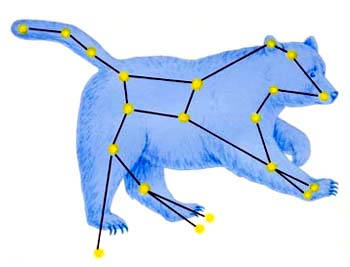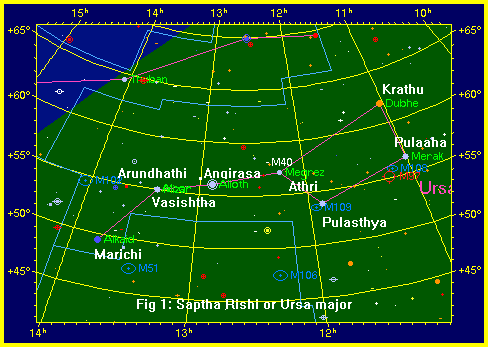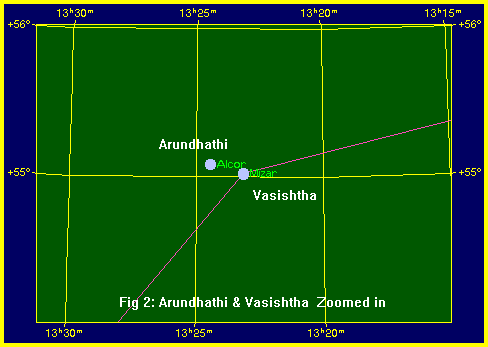Apr 14, 2025
Apr 14, 2025
During many traditional Hindu marriages, the presiding priest usually shows the bride, a star called ‘Arundhathi’ in the night sky. Sadhwi Arundhathi is the wife of sage Vasishtha. This famous couple from vedic times, well known for their harmony and devotion to each other, is revered as a an ideal couple worthy of emulation by all married couples. Nowadays not many can identify this star in the night sky. This article aims to help in identifying this star in the night sky for those who are interested. We have on Vriddha Garga’s authority that in the Northern Sky, the SapthaRishi’s revolve around Dhruva Nayaka like a necklace. From east to west the saptha muni's Marichi, Vasishtha, Angirasa, Athri, Pulasthya, Pulaaha and Krathu sit. Chaste Arundhathi accompanies sageVasishtha. These descriptions provide us with adequate information about the explicit astronomical identity of the nine stars, called as Dhruva, Arundhathi & Saptha Rishis’s. The Seven Sages are ‘Marichi, vasishtha, angirasa, athri, pulasthya, pulaaha, and kruthu’. Varaaha Mihira notes that Saptha Rishi’s circles around Dhruva naayaka (Ref 1), which clearly stands for Ursa Major & Polaris. He provides us the proper names of seven dominant stars, and attributes the origin of these names to sage ‘Vruddha Garga’. In all probability ‘Vriddha garga’ is same as ‘<>Gargya Rishi’ of Athrvana veda 19 kaanda 6-7 sooktha whose time was approximately 2400 BC.(Ref 2). Figure 1 and 2 illustrate a sky view of Ursa Major(Ref 3) from a modern astronomical software. This constellation in Northern Hemisphere appears to rotate around the pole star Polaris. ‘Dhruva’ clearly is Polaris Figure 1 shows the night sky with ursa Major/Saptha Rishis. The red line joining the seven dominant stars provides us with the shape of a ‘Big Dipper’. Star identities Mizar and Alcor fall on each other. The saptha Rishi’s are the seven major stars of Ursa Major. Based on VaraahaMihira’s verses, we can easily identify starting from east, that ‘Marichi’ is Arab Alkaid, 'Vasishta' is Mizar, 'Angirasa' is Alioth, ‘Athri’ is Megrez, ‘Pulasthya’ is Phecda, ‘Pulaaha’ is ’Merak and ‘Krathu’ is DuBhe. The companion star for Mizar is Alcor. Hence ‘Arundhathi’ stands for Alcor. In the figure 1, Vasishta and Arudhathi (Mizar-Alcor) can not be seen separately. Figure 2 Shows the zoomed in picture of the stars near Mizar. The star Arundhathi is difficult to separate from Vasishta for people with poor eyesight. Arundhathi’s brightness is a fourth magnitude star and is within 0.2 degrees of Vasishtha, which is twice as bright. Marichi Alkaid 85 h UMa HD 120315 44752 1.86 The table provides the modern astronomical identity of the nine stars from Vedicperiod, not in the ecliptic track. The 27 daily stars are in ecliptic plane. Dhruva(Polaris) is not illustrated in any of the figures, as its identity is very well known in the sky. Other cultures of the world also have historically used the keenness of eyesight to distinguish between the two starsVasishtha-Arundhathi (Mizar-Alcor) as an asset. In India, it is said anecdotally that people who are approaching death can not separateArundhathi from Vasishta and hence cannot see Arundhathi. Perhaps eyesight has more to do with this. In conclusion this article hopefully will assist those who wish to identify Arundhathi and Saptha Rishi’s in the sky. In USA, which is in the Northern Hemisphere, Ursa Major is easily visible most of the year.
 The star pair Arundhathi-Vasishtha is in the famous constellation Ursa Major. It is also called Big Dipper or Great Bear. In India this constellation is calledSaptha Rishi mandala (Seven Sages). Vasishtha is one of the seven Rishis. The astronomical identity of these stars is very easy to establish due to explicit definitions given by Varaha Mihirain his Brihat Samhita (Ref 1 - circa 550 AD).
The star pair Arundhathi-Vasishtha is in the famous constellation Ursa Major. It is also called Big Dipper or Great Bear. In India this constellation is calledSaptha Rishi mandala (Seven Sages). Vasishtha is one of the seven Rishis. The astronomical identity of these stars is very easy to establish due to explicit definitions given by Varaha Mihirain his Brihat Samhita (Ref 1 - circa 550 AD).
Varaaha Mihira in his Brihat-Samhitha, dedicates 13th chapter to Saptha Rishis. The relevant verses provide following descriptions roughly translated as;


Nakshathra
Arab Name
Bayer Identity
Henry Draper
SAO
Brightness
Vasistha
Angirasa
Athri
Pulasthya
Pulaaha
Krathu
Arundhathi
Dhruva
Mizar
Alioth
Megrez
Phecda
Merak
DuBhe
Alcor
Polaris
79 z UMa
77 e UMa
69 D UMa
64 g UMa
48 b UMa
50 a UMa
80 UMa
1 a UMi
HD 116656
HD 112185
HD 106591
HD 103287
HD 95418
HD 95689
HD 116842
HD 8890
28737
28553
28315
28179
27876
15384
308
28751
2.27
1.77
3.31
2.44
2.37
1.79
4.01
2.02
References
1) M.R.Bhat - Brihat-Samhita of Varaaha Mihira; (Original Sanskrit text & English commentary)
Motilal Banarasidass Publications, 1981.
2) S.Balakrishna - Names of Stars from Period of Vedas, 1998
3) Wayne Annala - Load-Star Pro Software, Zephyr Services, Pittsburgh, 1994
15-Jun-2000
More by : Dr. S. Balakrishna

|
How is saptha Rishi Mandal different from other Nakshatraas of Hindu Astrology they are also called asterism. Why is Saptha Rishi mandal not included in them ? Partha |

|
Thanks a lot.Good work |

|
"(…) the famous constellation Ursa Major. (…) is also called Big Dipper or Great Bear. In India this constellation is called Saptha Rishi mandala (Seven Sages)." That passage is mistaken and does not agree with this one, which is accurate: "The Saptha Rishis are the seven major stars of Ursa Major." The pictures show that the Big Dipper is not the same as the Great Bear but only part of it: its seven brightest stars (the tail, the hip and the hind part of the back), so it's not a constellation but an "asterism". (Also, those who saw a bear there were not well acquainted with bears because they don't have such long tails, but tails that are as short as a rabbit's.) I've always lived in big cities, where the glare makes it impossible to see anything other than the Big Dipper, as far as the Great Bear is concerned. Its other stars are so weak that I've NEVER see the entire bear, and might never ever see it. |

|
Wonderful information. I am a novice in the field. But I want to know more and more details. I was wondering weather our star names can be found with correct description. Thanks a lot for ready reference. |

|
kindly clarify the saptharishies are 1 kasyaba sage 2 athrisage 3 Bharathvajar sage 4 Viswamithar sage 5 Gowthamar sage 6 Jamathni &7 Vasistara sage or the names you indicated Thank you |

|
wonderful combination of mythology and astronomy |